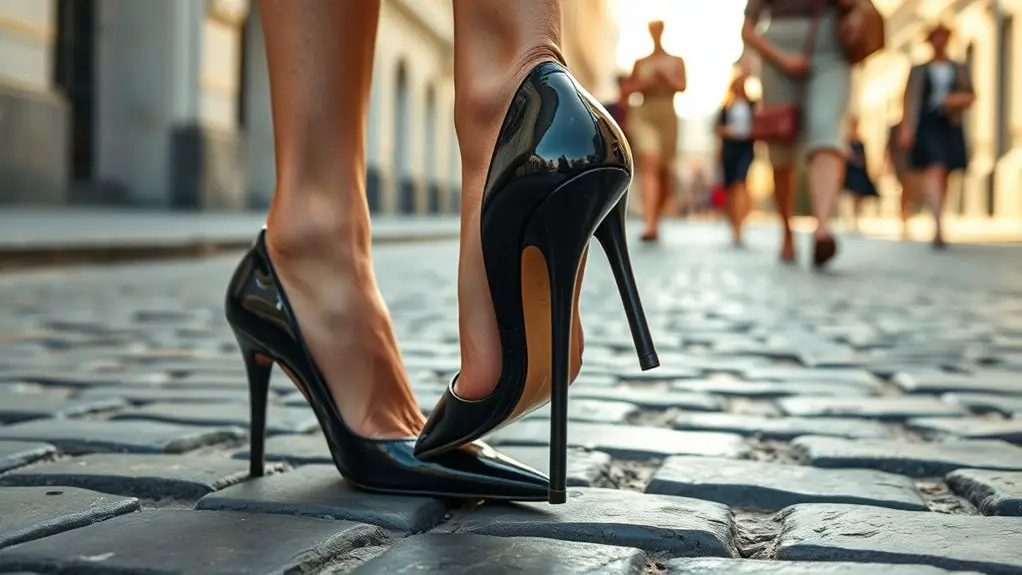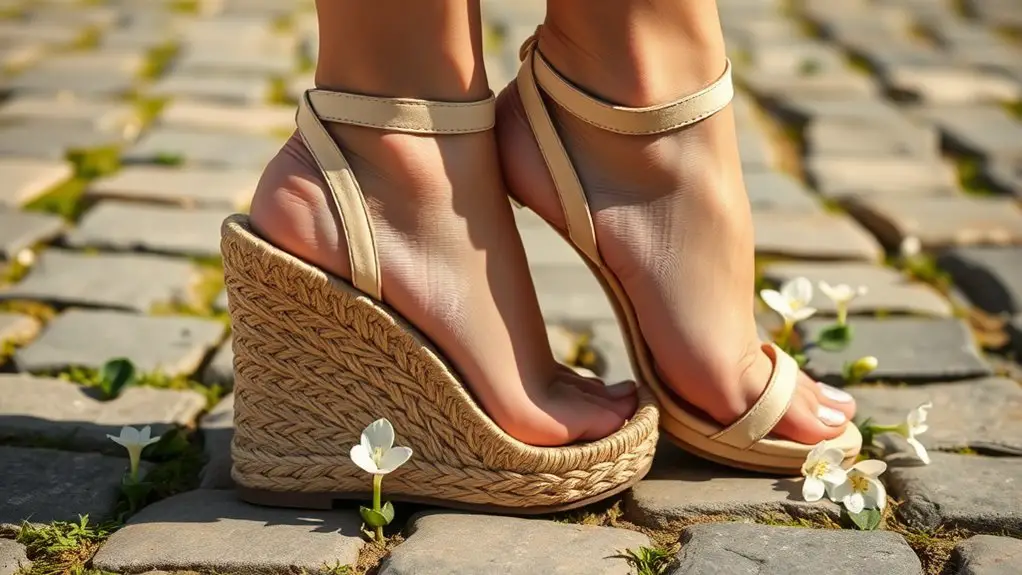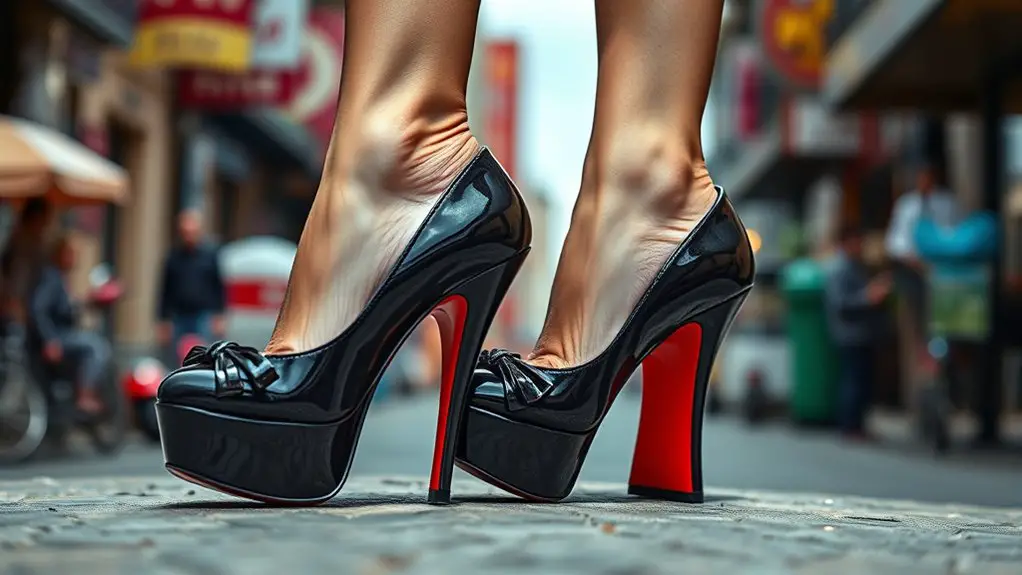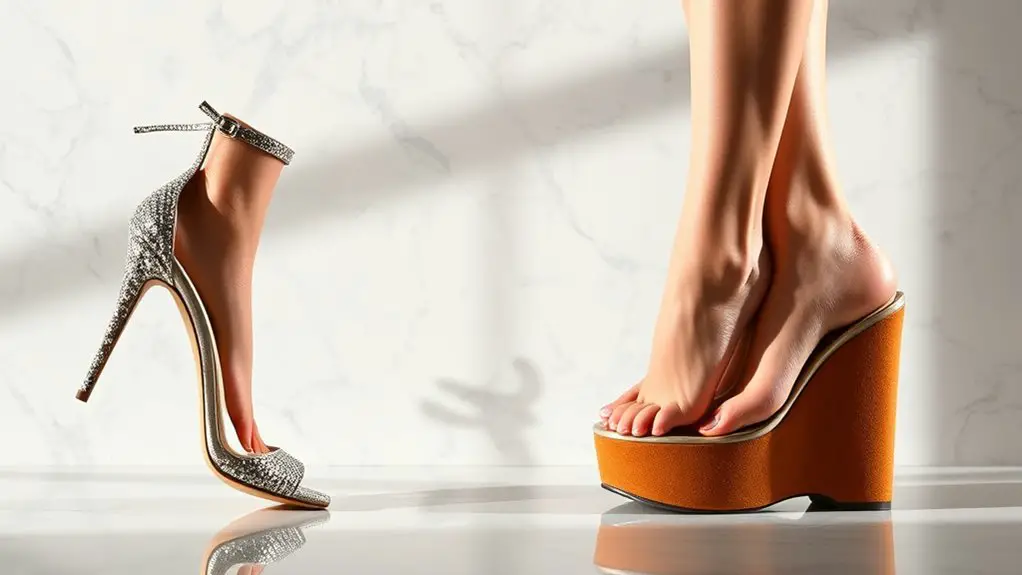If you have weak ankles, you’ll want to steer clear of stiletto heels, platform sandals, and wedge shoes. These styles offer little ankle support and can increase the risk of sprains. Slingback heels may also compromise stability, while spool heels can put strain on your ankles despite their shape. Even overly high block heels can be a risky choice. Choosing the right footwear is key for your safety and comfort. Discover safer options to keep your feet happy!
Stiletto Heels

While you might love the elegance of stiletto heels, they can be a risky choice if you have weak ankles. The slender design, often with a high heel, puts undue pressure on your ankles, making them susceptible to twists or even sprains. Each step can feel like a balancing act, and the risk of falling is heightened, especially on uneven surfaces.
Fortunately, there are plenty of stiletto heel alternatives that provide style without compromising your safety. Consider block heels or kitten heels, which offer more stability and support. These options maintain a chic look while being easier on your ankles. If you do choose to wear stilettos, prioritize stiletto heel safety by opting for styles with ankle straps that provide additional support. Remember, it’s possible to look fabulous without risking your well-being—your ankles will thank you!
Platform Heels
When it comes to platform heels, you might be tempted by their bold height and stylish flair, but they come with their own set of challenges. While the thick sole can provide some cushioning, it often compromises ankle support, leaving you vulnerable to instability. If you have weak ankles, it’s essential to evaluate how these towering shoes can affect your balance and overall comfort.
Height and Stability Concerns
Although platform heels can offer a fashionable lift, they often pose significant challenges for women with weak ankles. The elevated height can compromise stability, making it difficult to walk gracefully. If you’re considering ankle strengthening exercises, these heels might not be the best choice. Instead, explore heel alternatives that provide better support.
| Height of Platform | Stability Rating | Recommended Alternatives |
|---|---|---|
| Low (1-2 inches) | Moderate | Block heels |
| Medium (2-3 inches) | Low | Wedge heels |
| High (3+ inches) | Very Low | Flats or sneakers |
Choosing the right heel is vital. Opting for styles that enhance stability can help you feel more secure and confident on your feet.
Ankle Support Limitations
Even if platform heels seem like a stylish choice, they often lack the ankle support necessary for women with weak ankles. The elevated sole can create an unstable surface, making it challenging to maintain balance. Without proper ankle support, you could risk rolling or twisting your ankle, leading to painful injuries. While there are ankle brace options available, they can clash with the aesthetic of platform heels, leaving you feeling torn between fashion and safety. Instead, consider opting for supportive footwear that combines style with stability. Look for shoes that offer a secure fit, cushioning, and a lower heel height to guarantee your ankles are protected without sacrificing your fashion sense. Your feet will thank you!
Wedge Heels

When it comes to wedge heels, you might find them stylish, but they can pose real challenges for weak ankles. The limited ankle support and unstable walking surface increase the risk of sprains, making each step a potential hazard. If you’re looking for comfort and stability, it’s best to reconsider these trendy options.
Limited Ankle Support
While wedge heels may seem like a stylish choice for adding height, they often come with limited ankle support that can be particularly problematic for those with weak ankles. This lack of support can lead to discomfort and instability, making it essential to explore alternatives. If you’re seeking supportive footwear options, consider these ankle brace alternatives:
- Low-heeled sandals – They offer a more stable base.
- Flats – With no elevation, they keep your ankles grounded.
- Ankle boots – They provide coverage and support along the ankle.
- Chunky sneakers – These combine comfort and style while ensuring stability.
Risk of Ankle Sprains
Wearing wedge heels might elevate your style, but they greatly increase the risk of ankle sprains, especially for those with already weak ankles. These stylish shoes often lack the stability and support your feet need, making it easier to twist or roll your ankle. The elevated design shifts your weight forward, forcing your ankles to bear an uneven load, heightening the likelihood of ankle injuries. When considering your footwear choices, remember that beauty shouldn’t come at the cost of your safety. Opting for supportive shoes can greatly reduce the chances of sprains and keep you on your feet. Prioritize comfort and stability over trends, and your ankles will thank you in the long run.
Unstable Walking Surface
Have you ever noticed how wedge heels can turn a simple stroll into a precarious balancing act? Their wide base might seem stable, but uneven terrain can quickly lead to missteps, especially if you have weak ankles. The angle of wedge heels often disrupts proper foot alignment, making every step a challenge.
Consider these factors before slipping into your wedges:
- Height of the wedge: Taller wedges can increase instability.
- Material: Hard soles may not absorb shock from uneven surfaces.
- Design: A narrow top can limit your foot’s grip.
- Terrain: Grass, cobblestones, or gravel can exacerbate instability.
If you’re prone to ankle issues, it’s wise to rethink those wedges!
Spool Heels

Spool heels, with their distinctive hourglass shape, may seem like a stylish choice, but they can pose challenges for women with weak ankles. While spool heel advantages include enhanced stability compared to thinner heels, the design can still lead to ankle strain, especially with prolonged wear. The wider base at the bottom can provide some support, but the narrow top may not offer enough security for your ankles, making it easy to twist or roll them.
If you’re looking for spool heel alternatives, consider block heels or wedges. These options distribute your weight more evenly and provide a broader support base, reducing the risk of injury. When choosing footwear, always prioritize comfort and stability, especially if you have weak ankles. By selecting the right styles, you can maintain your fashion sense without compromising your safety.
Slingback Heels
Slingback heels might look chic and versatile, but they can be tricky for those with weak ankles. The open back design, while stylish, can compromise the support your ankles need. If you’re considering these heels, keep in mind:
Slingback heels offer style but may challenge those with weak ankles; consider support and comfort before choosing.
- Slingback Materials: Opt for softer materials that provide some flexibility, like suede or leather, rather than stiff fabrics that can create pressure points.
- Heel Height: Choose a lower heel height to minimize strain on your ankles. A manageable height is essential for stability.
- Adjustable Straps: Look for styles with adjustable straps to guarantee a secure fit, preventing your foot from slipping.
- Cushioned Footbeds: Heels with added cushioning offer better support and comfort, reducing the risk of ankle instability.
While slingback heels can elevate your outfit, prioritize comfort and support to protect those delicate ankles. Choose wisely!
Overly High Block Heels
While block heels can offer stability compared to stilettos, overly high block heels can pose significant challenges for women with weak ankles. The height can put excessive pressure on your joints, making it easy to lose balance. Even with a wide base, the extra elevation can amplify the risk of twisting or spraining an ankle.
Instead of reaching for those towering block heels, consider exploring fashion alternatives that prioritize both style and comfort. Chunky, lower block heels provide a chic look without compromising your stability. Ankle support is crucial, so look for shoes with cushioned insoles and secure straps.
Don’t forget about comfort options like stylish flats or supportive wedges. These choices can keep you looking fashionable while ensuring your ankles stay safe and sound. Remember, it’s all about striking that perfect balance between elegance and ease, allowing you to enjoy every step confidently.
Frequently Asked Questions
What Are the Best Shoe Styles for Weak Ankles?
When considering the best shoe styles for weak ankles, you can’t go wrong with comfortable flats and supportive sandals. These options provide stability and cushioning, helping you avoid discomfort while keeping your feet stylish and secure.
How Can I Strengthen My Ankles for Better Support?
Did you know 1 in 3 adults over 65 experience falls? To strengthen your ankles, focus on ankle flexibility exercises and balance training. These practices enhance stability, reducing injury risk and improving your overall mobility.
Are There Specific Exercises for Weak Ankles?
Yes, there are specific exercises for weak ankles! Incorporate ankle stability exercises like single-leg stands and proprioception training using balance boards. These activities enhance strength and coordination, helping you build a solid foundation for your ankles.
What Should I Look for in Supportive Footwear?
When choosing supportive footwear, look for durable materials that offer stability. Prioritize designs with reinforced ankle support, cushioned insoles, and a firm heel counter to guarantee comfort and prevent injury during daily activities or workouts.
Can Ankle Braces Help When Wearing Heels?
Imagine wearing an anchor on your foot; ankle braces can stabilize your steps in heels. Consider low heel heights and supportive brace types to enhance comfort, ensuring you don’t feel like you’re walking on a tightrope.



